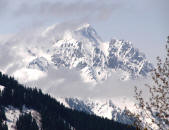NEWSLETTERS
Jump to bottom to read the Fuel Study conducted by the Family Motor Coach Association & very funny travel log from a customer
The Tours were exceptional.
First tour, The first tour saw plenty of bears and, of course, numerous cubs. Also, one lynx was seen, not to exclude all the others: moose, caribou, elk, to name a few. The marine mammals were all represented too. The weather started off warm, and spring came in fast. The flowers were in bloom within days. All the tours and attractions were up and running, even the Yukon spring breakup came before we arrived. The luxury of using the George Black ferry was appreciated. Even Mount McKinley showed its face one afternoon. The King Salmon Derby was going on in Anchorage and someone in our group caught a 40lb Halibut. Many photos and shared filets for all. With only two days of rain, less bugs and 22 hours of sunlight, the first tour is always a hit.
Second tour, The second tour started warmish. The baby animals were adolescents. The Salmon were running up every creek and stream. Of course, the bears were right in the middle of the fight, big and fat. The Fireweed and all the arctic flowers were in full bloom, carpeting the whole countryside. We found gold while panning on Bonanza Creek in Dawson. Fairbanks tours were great. Just about everyone went on all tours and had a great time. Mount McKinley was showing from top to bottom with a full moon in the background (a real Kodak moment). Plus, we saw the "Northern Lights" almost every night the last two weeks of the tour. Alaska State Fair was fun. Near the end of the trip we could tell Fall was in the air. The short and fast Summer had come to an end. As we drove back down the ALCAN, every tree and bush had turned gold. It would be a sad occasion normally, but we know we are going back again next year. I can’t wait for next Summer and all the new friends and adventures it will bring.
We keep our caravans down to 18-22 rigs so we can see and do more. Unfortunately, there is limited space. I hope to see you on the tour, so make your reservations now. (Good Sam, FMCA and AARP, when signing up, don’t forget to ask for your free vest.)
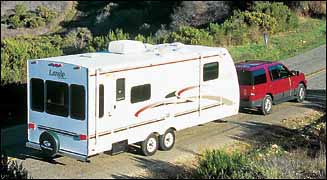
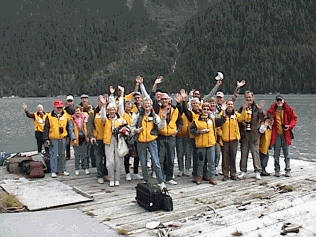
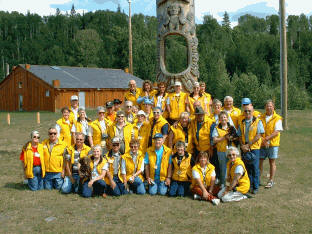
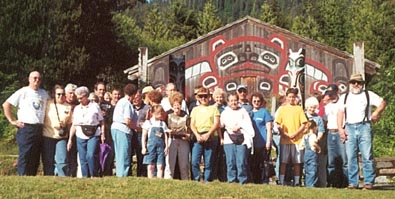

Travel
Log:
BC in glacier country. A Sarah Palin
coffee mug was ours for coming the furthest to join the group.
Yippie!
Our
caravan leader, bearded professor, Spike, was in his element during
the first of three orientations. Geologic history, Gitxsan, First
People history (don’t call them Indians or Native People in Canada),
VHF Radio explanation (we communicate in our vehicles with these
devices), ¼ inch of daily tour information.
Spike’s
lecture on Coping made
the most impression. Why didn’t I hear this earlier in the week when
we were on a steep, glaciated mountain dirt road with gullies on
both sides! Like any good teacher covering bases, Spike modeled the
proper coping procedure we should use:
Camper, “Help, there is a
G.D. leak in my rig!” Spike
“Not coping too well this morning, are you”
Better way, according
to Spike, speak first to Jim
(tail gunner/ volunteer assistant) “There seems to be water leaking
in my rig. Please put me on Roger’s list.”(Roger is our resident
mechanic).
Ok, instead of screeching, “Wayne, I
can’t take this anymore. Are you trying to kill us!” I should say,
“Wayne, dear, I fear we are going off the road into the brink.”
Easier to be nice to strangers than spouses.
Always an encounter to keep things
in perspective. Just met a lady from Virginia, a psychologist, who
lost her husband a year ago after being a caregiver for a long time.
So how does she cope? She bought a trailer. She and her girlfriend
took off for adventure.
First tour – We caravan in our tow
vehicles or trucks to totem central in First People’s town of
Kispiox. Do you know why authentic totem poles are bare
part way up? It is an artistic
devise to draw the eye to the top, where there will be special
carving. We expect to be full esoteric info.!
Second orientation meeting – The
Bear Lecture among other important things:
80 % of bear population is in
Alaska. Next we head to Hyder, Alaska, famed for its congregation of
bears catching spawning salmon. Although there was a bear trap in
Jasper and signs everywhere warning, “Watch for bears”, so far we
have only seen one black bear by the highway surrounded by curious
travelers
If we ever do meet a bear, we will
be prepared with this information when panic sets in:
·
Don’t get between a bear and its
food stash or its cubs.
·
Make noise, sing or carry jingle
bells, so Mr Bear will not be surprised.
·
Make yourself as tall as possible.
Sure!
·
Never run
·
Back away. Don’t scream or panic.
And if ever one is touched by a
bear, check to see if it is a grizzly or a black bear
If grizzly, drop into a fetal
position. Hopefully Mr. Grizzly will decide you are not a threat and
only cuff you a little. If black bear, do not drop, he will think of
you as prey. Grab a stick, shout, and slap at that bear. He will
decide you are not worth it and retreat. Oh, we caravaners love this
bear talk. Only one of Spike’s guests ever had a close and personal
encounter with a grizzly at Hyder and she froze. The bear went on
by.
Onward to Hyder, population 100, the
eastern most part of Alaska, the only community in South Eastern
Alaska accessible by roads---
August 11,
Hyder, Alaska, Bears and Bear Man.
Off to
Hyder - Linda off to see the bears. Wayne, bears, yes, and banking.
Need to do a little banking. Googled Hyder - - population 80. Well,
so much for banking.
At the
elevated wooded walkway in Hyder’s National Park’s Wilderness
Center, there are bears, big brown grizzlies, roaming the creek,
snatching spawning salmon. We see more bears, smaller black ones, in
natural habitat, at the dump, or by the post office, or
by the car while Wayne sits waiting for Linda, who is looking
for bears elsewhere.
“Bear
Man”
We
caravan with trucks and cars forty-five miles on a dirt and gravel
road up the mountains through mining country, passing downward
speeding double trucks loaded with gold ore, $500,000 truck load.
(Wayne always thought gold came from the first counter at Costco at
Xmas.)
The
summit – the parking lot, size 200 X 200 ft., looks down, across,
and up the crevassed Salmon Glacier with its blue translucent
tinges.
Dirty
pup tent, old car, small, portable table with postcards and DVD
glacier displays, only fixed structure, a public outhouse.
Bear Man, Linda pictured a heavily bearded mountain man. On
the edge of the cliff, a short, lean, mildly grizzled, jeans and
plaid shirt clad, seventy-seven year old guy – Meet “Bear Man”. More
like a brown PG&E type worker, thought Wayne. Mosquitoes buzzed
weirdly around his baseball hat. For 16 summers he has lived alone
beside the summit parking lot of this glacier. He hikes down steer
walls, over and under sixty foot glacier caverns. Here’s part of his
story:
Real
sphincter tightness when you hear a cracking above you. People hike
ONCE with me. They don’t like that you have to crawl up this steep
cliff to get back to parking lot.
This is
the greatest day of my life. Just experienced the big plug break
loose. That enabled glacier water to flow down to the river with 100
X 100 ft. blue ice chunks. About time to amble back to my family in
New Brunswick.
Bear
Man used to lecture at schools back home.
In
response to Wayne’s brilliant question, “With all these beautiful
mountains and glaciers, where are all the other hikers?” “Well
son, people don’t much like to hike where there are grizzlies.”
“Oh.”
Bears,
you should hear Bear Man’s other stories,
particularly the one about his defensive curling into fetal
position during bear attack.
Our own
caravan’s local color: Four Floridian couples and three Texans, a
sprinkling of Mid Westerners, Tennesseans, Arkansans, and Coloradans
(Is that right?). We are the only Californians. Wayne is colorful,
but I think the Texans and Floridians have him beat.
The
Texans are nice, outgoing. Couple #1, the Tines: Judy, Texan country
club dress, Chuck, ironed Levis with a crease; both have smart black
cowboy hats with silver bands. Wayne’s idea of formality: small
coffee stains are okay. Sometime ago Judy fell off a dam wall and
broke her back, so she walks with a red designer cane. She is
upbeat, goes with the flow even up the Chillkoot trail.
Tines’ description of their first date - hunting. Judy drops
a deer with one shot at 250 yards.
Chuck, “Now what?”
Judy, “Hang it from that tree over there and you can filet
it.”
Chuck,
“Dear, you shoot it, but you can’t clean it?” Judy, “We always have
people to do that.”
Chuck,
“Oh.”
Texans
#2, from Corpus Christie Beach - Doug, retired contractor of large
homes, his second wife, Connie, slightly younger, pretty platinum
Marilyn Monroe type. Yes, she has
them.
Out
there friendly, Connie, was raised as a daughter of missionary
parents on Chinle Reservation, married at a young age to an American
Indian, had 6 children from this marriage, stayed single until they
were raised. Presently, she is trying to sell their beach front
home. “He is always downstairs somewhere and I’m upstairs. I am
tired of living separate lives in this big house. I want to go full
time so we can spend more time together.”
Spunky gal, at our first Sunday prayer group, Connie sang
acapella (spelling, can’t find it?) Yes, our leader Spike holds a
Sunday service when we are far afield of churches. Spike’s first
sermon, Coping. Linda
took that one to heart. Second sermon,
Thankfulness. Oh, yes.
Relating the previous Texan stories to Peter, visiting German
architect on RV staff, he replied, “First time in Texas I went to a
bar/restaurant; I said to my wife, oh, God, we interrupted a costume
party”. Wife, “No, dear, this is normal Texan get up.”
“Oh!”
Onward
to Skagway and Dawson City, Yukon Territory
Skagway, Alaska, our caravan
riffraff met the “Boat People”, cruise ship tourists, so named by
our caravan leader, Spike. He handed out disinfectant so we wouldn’t
catch colds from the hordes of people on the streets. Our RV’s
shared the docks with cruise ships at a harbor with unbelievable
glacier views.
A little cultural education Klondike
style: Linda in Skagway bookstore, Wayne dragged her down the street
past five or six jewelry stores into the Red Onion Saloon, a bar and
standard restaurant. End of room, high above the crowd, twelve wide
stairs, the Brothel Entrance. A scantily clad hostess entreated us
to tour the infamous upstairs. Tickets purchased, Linda hunkered
down behind the other ticket holders so nobody from California,
particularly former students would see her. Brothel’s business model
was unique. On the bar sat a selection of porcelain dolls. These
were models of “Ladies of Negotiable Affection”. Customer made a
selection and the doll was laid horizontally on the bar. Proceeding
upstairs, client paid $5.00 for 15 minutes with the lady. Our
tourist ladies gasped at this statement.
In each room was a “money hole” where the Klondiker sent his
gold dust via copper tubing to the bartender below. The bartender,
in a timely, fashion, returned the corresponding doll to a vertical
position. Ready for another go! Another tidbit: Thin ladies were
considered unhealthy (wasting sickness). The fuller the woman, the
greater the fee, the ladies were weighed! This desire for added bulk
led to heavy gowns with metal sewed into hems. The phrase, “worth
their weight in gold” was born. You can’t get this on PBS.
Climbed a quarter of a mile of the
steep Chilkoot Trail, boarded a catamaran to visit Juneau,
Mendenhall Glacier & its hungry BEARS, took a dog sled, stayed in
Yukon’s biggest city, Whitehorse, heard No. 1 rated Iditarod musher,
Michelle Phillips, became one of her sponsors – enough experiences
to write a book!
Onto our favorite place, remote
Dawson City, Yukon Territory- its permafrost tilted wooden buildings
sat beside dirt like roads.
The town had real dirt roads until a few yrs. ago when roads
were paved with dirt like stain material imported from France.
Really! Still there was plenty of real dirt, enough so this town
felt authentic.
Poetry readings of famed local poet, Robert Service, (full hour,
extemporaneous), a tour of Jack London’s reconstructed cabin, Wayne
loved Dawson’s colorful features, but not as much as brothel tour.
Fifteen miles up a gravel road along
Dawson’s Bonanza Creek, site of original Klondike gold strike, we
panned for gold and found many heavy flecks along with garnets &
agates! When we panned, our findings were often classified, “Well,
it looks like gold to me!” Panning results, not living up to rich
expectations, was improved when Wayne exchanged pan for American
Express card and bought Linda a nice, petite, gold nugget, a memory.
Active claims on both sides of Bonanza Road came with the warning,
DO NOT TRESPASS. It was unbelievable how many active mining concerns
and heavy machinery were still operating. Canadian gov’t bought one
claim so tourists and its citizens could try gold panning in this
historic spot. Government’s rule was pan no more than twice a year.
No Canadian official was ever there that we saw. Honor system in
play, I guess. THIS WAS NOT DISNEYLAND.
One advantage of this tour, Spike,
with his twenty years’ experience and running radio commentary, took
us where no other RV tours usually go. From Dawson to Tok, it’s one
hundred and eighty seven miles. Six-thirty in the morning,
twenty-five rigs poised on the dirt banks of the rushing, mist
shrouded Yukon River, ready to cross on a single flatbed ferry,
which carried just two rigs per trip. Then up the hill to the famed
“Top of the World Highway”
In
the U.S. we build highways in valleys; in Canada they build on the
top of mountains. A winding road of dirt and gravel with many
construction stop. Alaska and Yukon have two seasons, Winter One,
Construction Two. We drove only 25-30 MPH.
Encounter
with clusters of caribou hunters (30,000 out there), with tents,
rifles, and ATV’s, hunters camped along the road awaiting start of
hunting season. Rolling along the highway with its unlimited
panoramas, we looked down to a creek, spied a bloody tarp with a
caribou head and a lucky hunter dressing the kill. Not exactly
Safeway. Folks here still depend on freezers full of game and fish.
Indian joke: What do you call vegetarian Indian? Poor shot!
Stopped in Chicken (Yes, that is the
town, so named when the founder couldn’t spell Ptarmigan, the
chicken like Alaska State bird), one of the coldest spots in North
American, minus 70 degrees in winter. How cold was it along this
highway? It closed this year in September just after we left. Prior
to 1949 sled dog was the only means of access to the area in winter.
No ordinary guide in Chicken. Former (36 yrs. ago) Head of Education
flew in his plane over our waiting heads to give us a tour of the
abandoned, historic town of Chicken. This delightful gentleman
originally got his job serving 38,000 square miles because he could
fly a plane. Chicken was a highlight for Linda. She loved visiting
the one room school house and bedroom annex of Tisha,
biography’s name and the Indian name for teacher. Tisha was a
young, naive teacher, who in 1929, went from Oregon to teach in the
bush. Her story, harrowing, heartwarming, came to life.
Believe us, this was another
world! In Tok, celebrated our “survival” of the Top of the World
Highway with a pancake toss, one of the games natives of Alaska
dream up during winter cabin fever and then reevaluate during the
spring. No one in our group under Spike’s and mechanic Roger’s watch
had serious RV problems, broken suspensions, cracked windshields, or
rig fires. More common than not! Hurrah! Not to minimize trouble,
one of our caravan friends was delayed due to surgery for a broken
arm. They had a tire blow out and a terrible rig fire. Thankfully,
they escaped, but lost their fifth wheel.
Okay, most famous bar game, the
Dawson Toe – In the news recently - Google it! Similar game, they
wouldn’t give Wayne the name, involved dog testicles. Don’t Google.
Winter lottery game for the folks
during river ice “Break-Up”: A tripod of tree limbs is placed on the
ice. The time and date when it falls over indicates break-up day. In
a small Yukon village, Nitichka, (sp.) we participated in town’s
lottery by predicting a late June break-up. Getting tired of Schwab
not having the results we want!
“Well, pilgrims,” as John Wayne
frequently said, “Let’s head’em out!” On to Denali and finally
Homer, the most western end of continental U.S. Key West, Florida,
to Homer, Alaska, a nice little drive.
September 5th,
Final
Alaskan Trekker Tales – Denali, Fairbanks, Anchorage, Homer, and
Home
Denali -
Biting wind swept through our RV park. Rigs, jammed behind tourist
storefronts, the last commercial facade before entering the national
park. Brilliant red moss and scarlet fireweed blanketed endless
tundra. From our little green tourist bus, we craned to catch specks
on steep mountainsides, a momma bear with two cubs, Dall sheep, and
a few caribou. Teeming with wildlife? Not exactly! Finally, a moose
foraged close by. Mt. McKinley was somewhere in the clouds.
Fairbanks – a gritty town - Great museum at University of Alaska,
mix of natural history, geology, Alaskan art in a contemporary
building atop a hill overlooking a vast countryside. We took a
memorable Sternwheeler ride past the home of Iditarod’s Susan
Butcher onto a stop at replica of a Native Alaskan Village.
Reminiscent of Disneyland, it was way too pretty to be authentic.
Never-the-less we loved it, especially the charming Native Alaskan
college guides and the caribou herd that galloped out on command as
the boat approached.
Further
south, Anchorage - Now this was the real thing, the Alaskan Fur
Exchange. Piled and hung was every kind of animal fur you can
imagine. Some critters’ heads and feet were off; most stared with
teeth grinning and claws sharpened. All were for sale. Visited a
knife shop nearby, avoided special locked cases of “weapons for
military and police” Didn’t want to know! Sea planes docked
everywhere. Number of pilots licenses in Alaska 1/7or 1/17? A lot!
It was
raining in the rain forest, as we rode through a local Anchorage
park.
Linda needed to see an urban moose.
“Drive
slow. You are driving too fast. Can’t see into the woods. Slower!
You are doing better. Are you watching your side? You are stopped.
You can’t stop HERE!”
“Linda,
a rather large moose is standing by the front left fender”.
“Oh!”
Click, Click, Click, Click.
At the
southernmost tip of the Kenai Peninsula on a little spit of land was
the City of Homer. In Homer’s mud and water, Wayne loved wearing his
knee high boots. Berthed in the harbor were ships from “World’s Most
Dangerous Catch”. Big, dark, and dirty, they would fit well in a
Stephen King novel. Here was the world’s best halibut fishing and
also a lot of eagles. Picture our little 9 lb. Shih Tsu running free
on Homer’s 35 foot tidal plane and Linda, scrabbling and screaming,
as she spied eagles perched on a tree trunk beached on the sand.
Meanwhile, Wayne couldn’t pass up a day of fishing. “Lots of big
halibut here,” thought Wayne. Prior to his trip, Linda handed him a
paper with names and addresses to send the extra frozen catch. The
result: nice day, but how do you split up 5 lb. halibut among three
recipients? Our tiny freezer nicely accommodated his catch.
Brave
cold and possibly choppy waters, not Linda! She and four other gals
took off for a Russian village for Samovar tea. Thirty miles down an
obscure road, we came to the onion domed church of Nikolaevsk. Among
nondescript, one-story track homes of the village, was the
combination house, café, B. &B., and gift shop of Nina Fefelov.
From the moment we stepped into Madam Nina’s “Cafe/Living
room”, we seventy year olds were transported back to being chatty
school girls. “No talking while I tell my story and pour tea. If you
like photos with ME, then you must dress up like proper Russian
folk.” And so we did. With Russian fur hats and head scarves,
colorful skirts and shirts, we giggled through photo taking. Amid
floor to ceiling relics and gift items, we carefully ate borsch,
piroshki, dessert, and sipped local Russian red fire weed tea. Madam
Nina, you found your calling – civilizing tourists.
Kenai -
another great fishing opportunity, salmon this time. Six thirty on a
dark and FRIGID morning on the misty Kenai River, reluctantly, Linda
headed out with Wayne and our fishing guide.
“We won’t catch much today. Recent storms churned up the
waters,” apologized our guide, Mark. “Great, here we go again,”
thought Wayne. Three hours later, Linda freezing and huddled over
her iPhone, texted to distract from the cold. (Jeans, long
underwear, a sweater, sweatshirt, and jacket didn’t cut it) Result:
one beautiful 10 lb. silver salmon. Wayne felt badly until he heard
no one else caught anything that day. Again our freezer was full!
Mark, warmly dressed in oil cloth, was young, big, all
shoulders. Aren’t they all! He had three different boats for three
different water ways. He and his wife camp out when hunting and
fishing on the tundra. His interest (Wayne always asked what people
did for fun.) was bow hunting where one had to get within 45 yards
to shoot. Hunting and fishing were not hobbies here. They were
subsistence goals. This young man had three 4’X 8’ freezers full of
fish, venison, caribou, and bear. He never bought any protein.
Done!
Homeward! “Linda, do you realize where our guy, Spike, left us?
THREE THOUSAND AND THREE HUNDRED UNESCORTED MILES from home!
Stocked with extra tires, hoses, filters, flares, Wayne had no idea
what to do with any of them. He previously relied on American
Express, AAA, Good Sam, a handful of twenty dollar bills, and Linda
showing a little cleavage in a pinch. Isolation descended. No
people, no cars, no towns, no cellphones. Every fifty miles was a
small paramedic truck parked in the forest. Off we went over roads
buckled with permafrost. It was like riding on the sloped back of an
elephant while trying stay in the middle. All the while, Linda
shouted, “Fissure on the right! Watch out, pot hole on the left!
That was a big one! Didn’t you see that? Truck coming, slow down; a
rock will break the windshield!”
Fortunately, from Spike, we learned the trick to driving Alaskan
highways: Drive forty miles an hour or risk a broken suspension and
other calamities; all the better to see hills of yellow aspen, dark
spruce flecked with snow, and white crested mountains.
Only
3,150 miles to go of endless terrain - There was the Yukon border.
Down a hill in darkness in the middle of nowhere was the White River
RV Park. Check- in included the usual stuffed grizzly and wolf
greeting us at the door. The proprietor was an attractive, smiling,
single, Irish lady who homeschooled her son in this isolated place.
Her son had just left for U. B.C Vancouver to major in physics. In
Canada no credit given for race or socio/economic circumstances –
Take the test, get grade, that’s it.
At least that is how it used to be.
After a
very cold night, both propane tanks were empty. “Holy smoke!” “What
is it?” “Come out here.” “We camped at the foot of a glacier.”
Mountains glistened in the sun as circling clouds parted on a
magnificent panorama.
Wayne
doesn’t take photos. Linda does. It was her turn to drive. Picture a
short lady on two pillows driving the truck and rig one-handed,
right hand wavering over the dash and snapping essential pictures.
Wayne, both eyes closed, teeth clenched, experienced a small taste
of religion as truck and rig fish tailed down the road.
Road
construction with time for conversation: Cute, blond, bundled up,
surfer type, looked all of sixteen years old, waved a flag. STOP.
“What do
you do for fun?” Wayne asked his perpetual question.
“After
my 12 hour work days on construction, I hunt, hike and fish,”
answered the gal with the $10,000 orthodontic smile.
“You
hunt!” quipped Wayne. (Sexist, oh, oh)
“I’m ALASKAN, you know. We all hunt!”
“What do
you hunt?”
“Mostly
small animals, recently my brother took me out to get my first
caribou.”
“Well- -
-.”
“He took
MY shot! Showing off to his new girlfriend, my brother took MY SHOT.
Going out again for caribou without him, nobody takes MY SHOT!
Road’s clear. You can go now.”
Rolling
through beautiful scenery, we finally hit West Vancouver in an RV
park at the base of northern end of Lion’s Gate Bridge. A five
minute walk on a bridge over the rushing Capiliano River, we watched
with envy men and women catching 10-20 lb. salmon.
Wayne mused, ”Think I would
like to rent a rod and go down there.”
Smiling
neighbor, a white spectator, answered, “No, you won’t.”
“Huh?”
“Fishing here is only for
First Nation People. Sorry, pal.”
Raining
like heck. No place on the street or in a parking garage for a truck
as tall as ours. Only small vehicles encouraged in Vancouver. So we
slogged a mile + to a fish and chips shop. On the way we stopped at
snappy furniture store for small spaces. We bought some imported
furniture for Sea Ranch. Deciding to save costs, we stuffed four
boxed chairs and a glass coffee table into the rig and truck. We
headed south. Imagine. Pause. The Beverly Hillbillies with small,
dirt encrusted, dented and damaged rig arriving stateside.
The end!
Family Motor Coach Association (FMCA) article on the rising gas costs and RV travel
Study: Motorhome trips cost less
Motorhome owners enjoy the advantages of traveling in a vehicle equipped with all the comforts of home ...
Avoiding airport lines and luggage restrictions. Having the flexibility to go where they want, when they want. Not having to pack and unpack their belongings in hotels or meet hotel check-in and check-out times.
Now, they can also bask in the glow of reports that RV travel costs less than other modes of travel such as car, train and plane.
Despite this summer’s record-high gas prices, RV trips remain the least expensive type of vacation, according to the results of a new study comparing vacation costs.
PKF Consulting, an internationally recognized consulting firm with expertise in travel and tourism, concluded that “typical RV family vacations are on average 26 to 74 percent less expensive than other types of vacations studied.”
For example, the study showed that a family of four traveling by type C motorhome from Washington, D.C., to Dennis Port, Mass., for 10 days would save $974, or 34 percent, over going by car.
PKF analyzed major costs that would be incurred by families taking nine different types of vacations to popular travel destinations such as the Grand Canyon; Orlando, Fla.; Cape Cod; Napa, Calif.; and Alaska.
PKF selected three types of RVs typically used by families for vacation purposes, including the type C motorhome.
“In all cases, RV trips were more economical than other vacations analyzed, regardless of trip duration, distance or region of the country,” said Kannan Sankaran, PKF’s lead researched for the study. “Even if fuel prices were to rise by up to 50 percent, our data show that each RV vacation would still be significantly less expensive.”
Vacations using a personal car, staying in hotels and eating in restaurants — the least expensive of the non-travel options — were found to be 36 percent more costly on average than going by RV.
The study showed, for example, that a family of four traveling by type C motorhome from Washington, D.C., to Dennis Port, Mass., for 10 days would save $974, or 34 percent, over going by car.
On a trip from Atlanta to Orlando for the week, a family of four would save $1,658, or 53 percent, by traveling in their motorhome and staying in campgrounds averaging $27 per night, instead of flying, renting a car, or staying in hotels averaging $125 per night and eating in restaurants.
Shorter getaways also were found to be more economical by RV. A family taking a three-day motorhome trip from Pittsburgh, Pa., to Lancaster, Pa., would save $1,049 – or 62 percent.
“While fuel costs are a component of the overall vacation costs,” Kannan said, “fluctuations in fuel prices aren’t significant enough to affect a family’s decision of whether or not to take RV trips over other types of vacations.”
In addition to major expenditures required from the start to finish of each vacation, PKF factored in an estimated cost of ownership of the RVs analyzed. Research included documenting average ownership periods, residual values, annual days of use, insurance and applicable IRS interest deductions for second-home mortgages.
